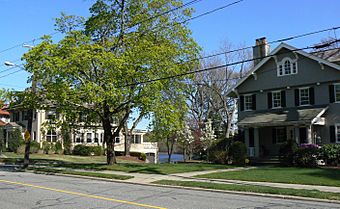Everett Avenue–Sheffield Road Historic District facts for kids
Quick facts for kids |
|
|
Everett Avenue–Sheffield Road Historic District
|
|

Everett Avenue and Niles Lane
|
|
| Location | Winchester, Massachusetts |
|---|---|
| Area | 49.38 acres (19.98 ha) |
| Architect | F. Patterson Smith, Dexter Blaikie |
| Architectural style | Colonial Revival, Bungalow/Craftsman |
| MPS | Winchester MRA |
| NRHP reference No. | 89000661 |
| Added to NRHP | July 5, 1989 |
The Everett Avenue–Sheffield Road Historic District is a special area in Winchester, Massachusetts. It's known for having some of the most beautiful homes built around the year 1900. This district is shaped like a triangle. It's bordered by Bacon Street, Church Street, Sheffield West, and Sheffield Road. On its other sides, you'll find the Upper Mystic Lake and the Mystic Valley Parkway.
The area features winding roads and large houses. These homes are on spacious lots. Most of them were built between 1890 and 1916. They all show off some really cool architectural styles. Many houses were designed by local architects F. Patterson Smith or Dexter Blaikie. This historic district was added to the National Register of Historic Places in 1989. This means it's officially recognized as an important historical place.
Contents
What Makes This District Special?
This neighborhood wasn't planned all at once. It grew over time. A famous Massachusetts politician named Edward Everett once owned land here in the 1850s. Everett Avenue is named after him. He was a well-known speaker and leader in his time.
Early Homes and Styles
The oldest house in the district is at 8 Everett Avenue. It was built in 1880. This home shows the Colonial Revival style. This style was very popular until the early 1900s. It often features details from early American colonial homes.
A great example of the Colonial Revival style is the Chadwick House. It's located at 24 Everett Avenue. Architect F. Patterson Smith designed it. This house has stucco walls with brick details. You can see the brick on the corners and around the windows.
20th Century Designs
As the 1900s began, house styles changed. Homes built then often used Neo-Rationalist, Tudor Revival, or Craftsman designs. Many of these newer homes were designed by Dexter Blaikie or Phineas Nickerson. Sometimes, they even worked together.
Dexter Blaikie designed a house for himself at 45 Everett Avenue. It's a simple example of the Tudor Revival style. This style often looks like old English country homes. A more detailed Tudor Revival house is the Martin House at 23 Sheffield Road. Blaikie and Nickerson designed this one together.
How Many Homes Are Historic?
The district has 129 properties in total. Most of these homes are important to the district's history. Only 20 properties are not considered "contributing." This usually means they were built too recently. For a building to be historic, it generally needs to be at least 50 years old. Also, a few buildings have been changed too much. These changes don't match the original style.



